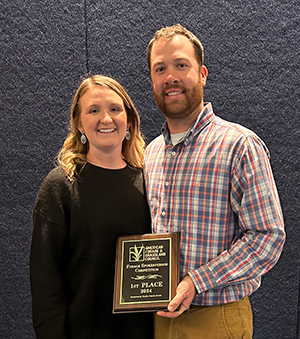This Kentucky farmer started from scratch |
| By Amber Friedrichsen, Associate Editor |
|
|
 Oftentimes, the hardest step to take toward achieving a goal is the first one. This is especially true for new and beginning farmers or those branching away from the family business. As someone who found himself in the latter situation, Matthew Isaacs’s biggest piece of advice is to simply get started. Then you can make adjustments along the way. At last week’s Heart of America Grazing Conference in Cincinnati, Ohio, Isaacs shared lessons he has learned since starting his own grazing operation. After buying a 70-acre farm and establishing a forage system from scratch, the young farmer from Hart County, Ky., and the winner of the American Forage and Grassland Council’s 2024 Forage Spokesperson Contest emphasized the importance of putting ideas into action.  Matt Isaacs and his wife, Madison, at the American Forage and Grassland Council’s 2024 Forage Spokesperson Contest in Mobile, Ala. Isaacs’s parents used to own a 300-cow dairy in the 1980s, which was the largest herd of registered Holsteins in the state of Kentucky at the time. When hardship hit during the farm crisis, they sold their cattle but continued to grow crops. Isaacs grew up farming alongside his father, instilling in him the value of hard work. Then five years ago, he purchased his own land and applied this acquired work ethic to make his dreams a reality. Fences came first Isaacs’s farm is wedged between a busy state highway to the northeast and a 30-acre subdivision to the south. To mitigate the liability of cows getting out and ensure the safety of drivers and his future neighbors, the first task on his to-do list after he bought the property was to build a perimeter fence. Isaacs knew this would involve a steep installation cost, so he made a deal with the adjacent landowner who would pay for a portion of the fence if Isaacs would do all of the work. “Before any houses went up, I said ‘I’m going to put a fence up, you’re going to pay for it, and I’m going to do the labor,’” Isaacs recounted. “I was able to fund the whole project with that one stretch of fence and by doing the work myself.” Isaacs also fenced out a small pond in the middle of his new farm. He left gaps in the fence that open to several paddocks so his black Angus cattle would have access to shade under the trees surrounding the pond. Isaacs said this would be essential to beat the heat and humidity of summer in Kentucky. Phase one, two, and three Once this infrastructure was in place, it was time to rejuvenate the cropland. It had a history of tobacco production and was more recently used to grow corn and soybeans for the past two decades. When Isaacs arrived, the soil was virtually depleted of nutrients, and most of the field was overcome with noxious weeds. He broke down his pasture renovation plan into three phases. Phase one entailed seeding sorghum-sudangrass across the field and grazing a herd of 40 yearling heifers on the annual forage during the summer. This jumpstarted plant growth on the bare ground and instigated some weed suppression. Phase two was to establish permanent pasture. Isaacs sought out cost-share opportunities with the Natural Resources Conservation Service (NRCS) and the Environmental Quality Incentives Program (EQIP) to help offset establishment expenses. The beginning grazier resolved to plant a mixed stand of cool-season grasses and legumes, including tall fescue, on 50 acres of his farmland. To comply with the cost-share agreements, he was required to seed a novel-endophyte variety instead of toxic Kentucky-31 tall fescue. Additionally, he seeded orchardgrass, festulolium, and ladino clover. “When I drilled this in, I halved my seeding rates and ran across the field twice in a grid pattern,” Issacs explained. “The reason I did that was because I didn’t think 7.5-inch drill spacing was going to make a canopy fast enough. I spent the extra time and fuel to go across it twice.” The third phase of pasture renovation was creating a grazing rotation. Isaacs originally made 10 paddocks with polywire and implemented a 21-day rest period between each grazing event. After one season of trying this approach and assessing the results, he has been moving toward a more intensive grazing strategy to enhance forage utilization and regrowth. “The 21-day rest period was a great starting point, but I want to double that,” Isaacs asserted. “Now I want a 42-day rest period, and I want 30 paddocks.” Getting the hang of hay With 50 acres in perennial pasture, Isaacs decided to turn the remaining 20 acres into an alfalfa hayfield. He has since seeded orchardgrass into the alfalfa to boost stand density, and doing so has opened doors to a wider customer base of hay buyers. Isaacs harvests hay five times a year, making small square bales and selling hay by the bale. He aims to cut forage in the afternoon when sugar concentrations are high and prioritizes leaf retention during raking and baling to maximize crude protein levels. In addition to grazing cattle and making hay, Isaacs grows corn and forage sorghum for silage. He said mixing the two creates a product with elevated protein and more moderate energy levels compared to the individual feeds that he has had success in finishing steers on. Isaacs has also experimented with grazing and harvesting various other crops, such as crimson clover and cereal rye. Despite the uncertainty in all of these endeavors, he is not afraid to take the first steps in getting started on a new idea. With a lot of hard work and the occasional redirection, Isaacs’s vision for his beef farm is becoming clearer all the time. “You just have to have a starting point,” Isaacs concluded. “Stand behind what you believe in and work your way to that goal every single day.” |
